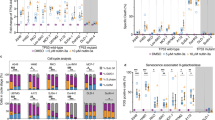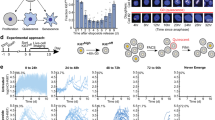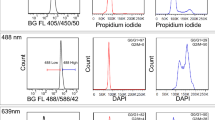Abstract
Cellular proliferative activity has previously been determined by measuring the incorporation of radiolabelled nucleotides or by visual inspection of cellular morphology. Although two flow cytometric methods1,2 have recently been developed which can distinguish cycling from non-cycling cells, both have serious disadvantages. One method requires uptake of a substantial amount of BUdR1, limiting its usefulness for in vitro systems. The other method utilizes RNA/DNA content differences2 but its successful application has proved cell-type dependent. We have now used the findings that the cell membrane is more highly polarized in resting than in proliferating cells3 and that cyanine dyes carrying a delocalized positive charge enter live cells to an extent that depends on the cell membrane potential4, to develop a method of distinguishing between cycling and non-cycling cells. The greater the membrane polarization, the greater is the concentration of dye within the cell. At high concentrations, the dye molecules aggregate and their fluorescence is quenched5. Thus, for a given external dye concentration, cells of different membrane potential would accumulate different amounts of fluorescent (non-aggregated) dye. Using fibroblasts in culture conditions chosen to provide various models of cycling and non-cycling cells, we found that fluorescence intensity with the dye 3,3'-diheptyloxycarbocyanine (Di-O-C7(3))6 was consistently greater in the former than the latter.
This is a preview of subscription content, access via your institution
Access options
Subscribe to this journal
Receive 51 print issues and online access
$199.00 per year
only $3.90 per issue
Buy this article
- Purchase on Springer Link
- Instant access to full article PDF
Prices may be subject to local taxes which are calculated during checkout
Similar content being viewed by others
References
Swartzendruber, D. E. Expl Cell Res. 109, 439–443 (1977).
Darzynkiewicz, Z. in Flow Cytometry and Sorting (eds Melamed, M., Mullaney, P. & Mendelsohn, M.) 285–317 (Wiley, New York, 1979).
Cone, C. D. Jr Ann. N. Y. Acad. Sci. 238, 420–435 (1975).
Bard, J. & Wright, M. O. J. cell. Physiol. 84, 111–120 (1974).
Sims Waggoner, A. S., Wang, C. H. & Hoffman, J. F. Biochemistry 13, 3315–3330 (1974).
Waggoner, A. S. A. Rev. Biophys. Bioengng 8, 47–68 (1979).
Horan, P. K. & Kappler, J. W. J. immun. Meth. 18, 309–316 (1977).
Pardee, A. B. Jimenez de Asúa, L. & Rozengurt, E. in Control of Proliferation in Animal Cells (eds Clarkson, B. & Baserga, R.) 547–562 (Cold Spring Harbor Laboratory, New York, 1974).
Johnson, L. V., Walsh, M. L. & Chen, L. B. Proc. natn. Acad. Sci. U.S.A. 77, 990–994 (1980).
Kinnally, K. W., Tedeschi, H. & Maloff, B. L. Biochemistry 17, 3419–3428 (1978).
Horan, P. K. & Wheeless, L. L. Science 198, 149–157 (1977).
Author information
Authors and Affiliations
Rights and permissions
About this article
Cite this article
Cohen, R., Muirhead, K., Gill, J. et al. A cyanine dye distinguishes between cycling and non-cycling fibroblasts. Nature 290, 593–595 (1981). https://doi.org/10.1038/290593a0
Received:
Accepted:
Issue Date:
DOI: https://doi.org/10.1038/290593a0
This article is cited by
-
Identification of haemopoietic stem cells
Cytotechnology (1993)
-
Mitochondrial dysfunction in yeast expressing the cytoplasmic male sterility T-urf13 gene from maize: analysis at the population and individual cell level
Molecular and General Genetics MGG (1993)
-
Photosensitization of human glioma cells by chalcogenapyrylium dyes
Journal of Neuro-Oncology (1989)
-
Low Ca2+-sensitive maxi-K+ channels in human cultured fibroblasts
Pfl�gers Archiv European Journal of Physiology (1988)
-
The effect of cytosine arabinoside upon mitochondrial staining kinetics in human hematopoietic cells
Histochemistry (1986)
Comments
By submitting a comment you agree to abide by our Terms and Community Guidelines. If you find something abusive or that does not comply with our terms or guidelines please flag it as inappropriate.



